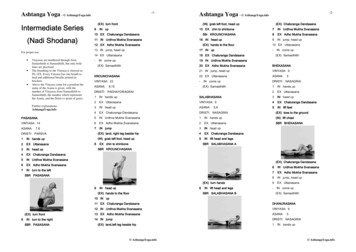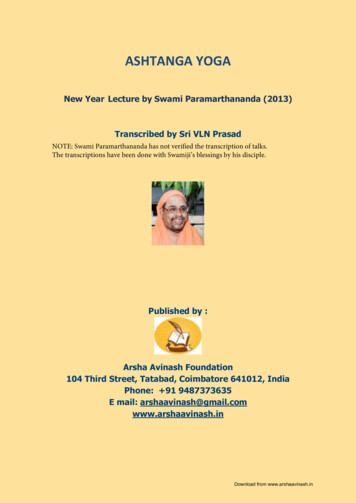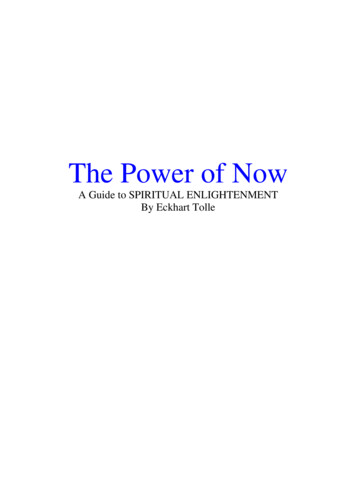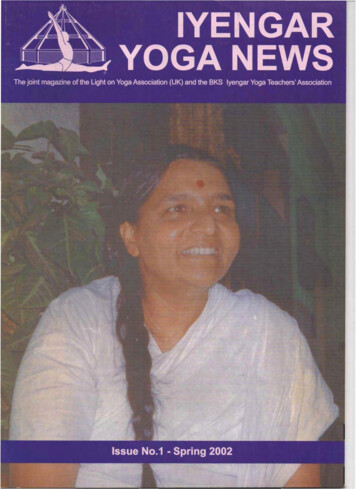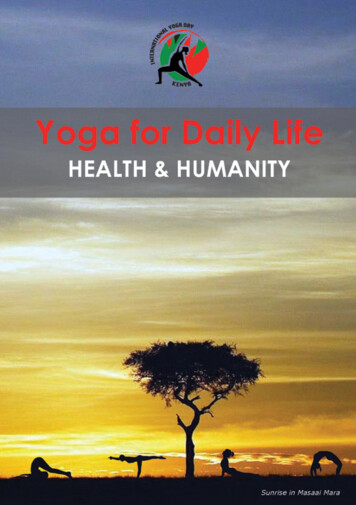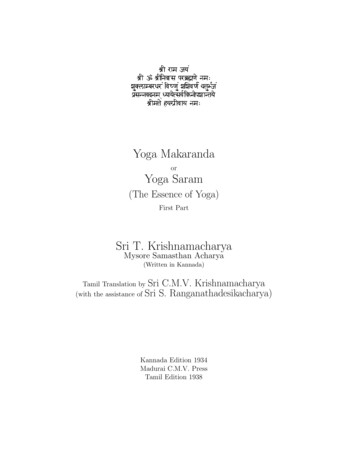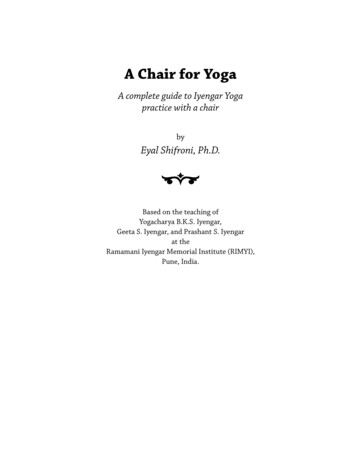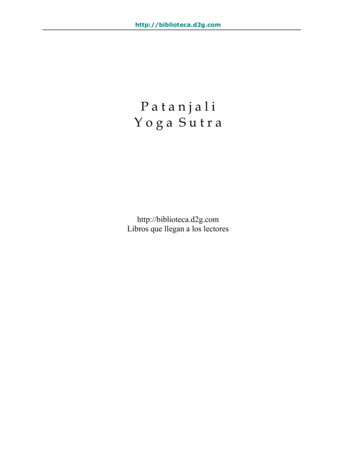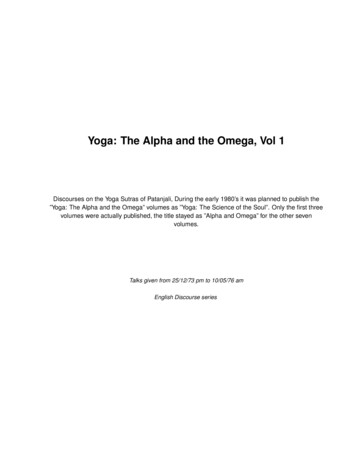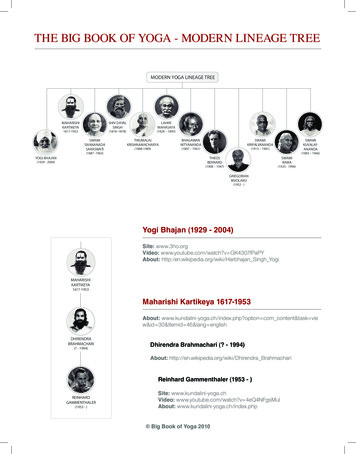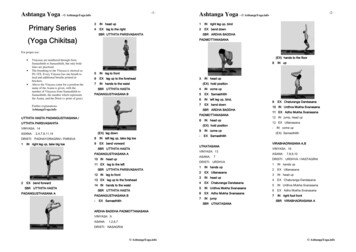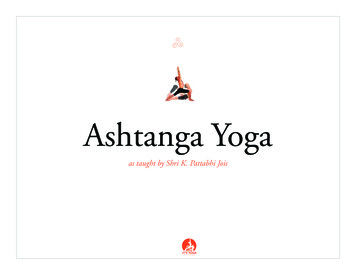
Transcription
yAshtanga Yogaas taught by Shri K. Pattabhi Jois
yShri K. Pattabhi JoisDo your practice and all is coming(Guruji)To my guru and my inspirationI dedicate this book.Larry SchultzSan Francisco, Califórnia, 1999
AshtangaAshtanga Yogaas taught byshri k. pattabhi joisCopyright 2000By Larry SchultzAll rights reserved. No part of this workmay be reprinted without the writtenpermission of the author.Published by Nauli PressSan Francisco, CACover and graphic design: Maurício Wolffgraphics by: Maurício Wolff & Karin HeuserPhotos by: Ro Reitz, Camila ReitzAsanas: Pedro Kupfer, Karin Heuser, Larry Schultz
yI would like to expressmy deepest gratitude to BobWeir of the Grateful Dead.His faithful support andteachings helped make thismanual possible.
Tforwardwenty years ago Ashtanga yoga was very much a fringeactivity. Our small, dedicated group of students inEncinitas, California were mostly young, hippie typeswith little money and few material possessions. We did have oneprecious thing – Ashtanga practice, which we all knew was verypowerful and deeply transformative. Practicing together created aunique and magical bond, a real sense of family.Over the years the Ashtanga family has grown considerablythroughout the world and I’ve had the opportunity to sharethe practice with many wonderful people as both a student andteacher. In Austin, Texas I met Larry Schultz 15 years ago whenhe was just beginning his Ashtanga practice with my teacher,Pattabhi Jois. Even though the practice was very challenging forhim, Larry approached it with great enthusiasm, optimism, andgratitude. He, like so many others, recognized immediately thatthis was exactly what he had been looking for and was very excitedby both the practice and the people involved in it.the past 5,000 years Ashtanga yoga has existed as an oral tradition,so when beginning students asked for a practice guide we wouldhand them a piece of paper with stick figures of the first seriespostures. Larry gave Bob Weir such a sheet of paper a couple ofyears ago, to which Bob responded, “You’ve got to be kidding. Ineed a manual.”Thus began Larry’s process of creating this manual, which has nowbeen completed with the help of several friends. Now, happilywhen beginning students ask for a practice guide we can offerthem this excellent, practical, and informative manual.Tim Miller5Senior Teacher Ashtanga YogaLarry and I have become close friends over the years and togetherwe have witnessed the profound positive impact the Ashtangapractice has had on hundreds of people’s lives, particularly ourown. We have developed many wonderful friendships within theAshtanga family and feel truly blessed to be able to share thepractice with others. Motivated by this desire to share the practice,Larry opened It’s Yoga in 1991, which has become one of thelargest and most successful yoga schools in San Francisco.A problem that Larry and I have encountered over the years ishow to keep beginning students going with the practice whenthey are unable to attend class due to work, travel, family, etc. Forpedro kupfer :: padmasana
conteúdoHow To Use This Manual .9Introduction.20The History of Ashtanga Yoga .11Awakening The Fire Within .12The Breath Of Life.13Prana.14Capturing Prana .15 Uddiyana Bandha .16 Jalandhara Bandha .17Drishti .18Cleansing And Purification :: Meltdown .19Creating A Sacred Place.21The Invocation.22Asanas .23Pranayama :: The Serpent Power .25Your Practice :: Helpful Hints .27Integration :: The Challenge.27Sun Salutations :: The Dawning of a Ritual .28Primary Series .32Bibliography.78About It’s Yoga .797
how to use this manualThe basics of ashtanga yoga cannot be learned enough. Becauseyoga practice is progressive it is important to go through thismanual in the order it is presented. However, if you are havingdifficulty with any of the postures go back to the beginning. Keepin mind that the true source of understanding is in the basicprincipals underlying the asanas. Take your time and learn thefundamentals of the practice. Go slowly. Never force or pushyourself into a posture, be patient, and all will come in time.What’s the rush?If you are experiencing any health problems, consult your yogateacher or a health advisor before beginning the exercises in themanual. This manual is a guide to be used in conjunction withclasses and is not a substitute for the personal attention andassistance of a teacher.Most of all, have fun! Enjoy the process of building your yogapractice and bringing peace into your life and those around you.One cannot understand therhythms and meanings of theouter world until one hasmastered the dialects of the body.Timothy Learyy9
You can’t diligently practice yoga, honingthe clarity of your mind, and fail tobe struck by the very humorous-albeitpathetic predicament we’re all in. Wefind ourselves chained to the wheel ofkarma, going round and round in ourown private illusory worlds, struggling toglimpse reality and attain eternal peace.It’s funny and maddeningly difficult, andsad, too, sometimes. It’s also the onlygame in town and nobody gets out alive.introductionGetting It TogetherSeparateness causes suffering and union creates freedom. Yoga isunion.From The Five Tibetansy10It is the separation from our Self, each other, nature, and fromsomething greater or higher (be it God, universal consciousness,or whatever term you want to use) that causes the anxiety andchaos symptomatic of our times. It is difficult for us to experienceour natural connection with each other when we don’t have thatconnection with our own Self. Yoga connects us with an innerwisdom, in which there is no doubt as to the connection of allthings.Now is the time for yoga. Yoga is a practical method of bringingpeace and connectedness back into our lives. Because we are areflection of our nervous system, the state of our nervous systemdictates how we experience the world. If the nervous system isfresh and rested, the body will be healthy and the mind alert andcomprehensive. As a result, our thought will be powerful and clearand our actions, which are manifested thought, will be successfuland rewarding.Yoga strengthens and purifies the nervous system so it can reflecta greater degree of consciousness and our lives can become anincreasingly positive force in the world. If the methods presentedin this manual are practiced correctly the whole nervous systemis revitalized, the body enjoys better health and more energy, themind is rested and freed from the endless burdensome thought offuture and past, and perception is restored to its primal freshness.We can actually gain back the connection to Self and others as weare released from the restricted thinking, dull mind, and negativityresulting from a strained, tired nervous system. The healthierour nervous system, the healthier our body, mind, thoughts andactions.The purpose of this manual is to make these techniques availableto all who are interested in enhancing the quality of their livesfrom the most fundamental foundation, the inner source. Theidea is to promote self-practice and self-responsibility, to offer atool for reconnecting. This is the place where yoga truly beginsin each of our own individual lives. Yoga helps you rise to thechallenge of living.
the history of Ashtanga YogaAs the story goes, the ashtanga yoga system was reconstructedfrom a mysterious manuscript written on a bundle of palm leaves,the Yoga Korunta. This collection of verses on hatha yoga wasdiscovered in the 1930’s by yoga master and Sanskrit scholar SriTirumalai Krishnamacharya and his disciple K. Pattabhi Jois whileresearching Sanskrit texts at a Calcutta university library. Themanuscript is dated to be between 500 and 1,500 year old.Krishnamacharya and Jois translated and reconstructed theashtanga yoga series (originally there were six sequences of postures)and Pattabhi Jois, with the encouragement of Krishnamacharya,took the instructions as the basis of his practice and teaching. Heis still teaching this method today in Mysore, India at the age of85.11Ashtanga taught by Pattabhi Jois is a form of hatha yoga whichfocuses on asana (posture) and pranayama (breath control). Somepeople call this ashtanga vinyasa yoga in order to distinguishbetween Patanjali’s eightfold system and the ashtanga yogadescribed in this manual.kukkutasana
It is in the very cavern of our heart thatwe can realize the immensity of spaces,and by controlling our own vital rhythmsthat we can escape the power of time.It is by reaching the source of life thatwe can escape the power of death. It isby exploring the unknown spheres withinourselves that we can visit the celestialand infernal worldsAlain Danielou.yawakening the fire withinVinyasa: Movement Breathing SystemAshtanga yoga wakes up the internal fire. It ignites the dormantflame of vital life energy within all of us. The vinyasa systemworks with the synchronization of deep, rhythmic breathingand movement. By linking the postures it creates a continuousflow of energy that heats up the body, bringing oxygen to theblood, nourishing the glands and internal organs, cleansing andpurifying the nervous system, releasing unwanted toxins throughperspiration. As the heat goes up toxins are burned up and out ofthe system, creating a lighter and stronger body, and a clear mind.The heat is not only a physical experience, it is an internal spiritualfire that burns through the fog of illusion and ignorance.Access All Areas12As the internal heat goes up, not only do the toxins begin to exitthe system, but another amazing thing happens; the body beginsto bend and move. As Pattabhi Jois says “even iron will bend withheat.” With this freedom of movement we are able to open upareas of the body that had been previously restricted or blocked.There is a release, a feeling of lightness. It is in these places thatwe can discover what yoga truly is. Yoga is not just a physicalexercise or some new way to pass the time or fill the emptiness,but a method of bringing life and vitality back into those areas,awareness of the deeper, inner parts of ourselves. It is a reunionwith that innate wisdom that we all posess, but seem to have losttouch with. Yoga was developed as a means of acknowledging orreturning to the source of life.As concentration increases, the breath, mind, body, and soulcome into union, to entrainment. Ashtanga yoga is a focusingtechnique that joins the main life forces, beating in unison toan internal rhythm, your internal rhythm. With control of thebreath, the mind becomes calm, allowing one to tap into a flowstate where there is no sense of time, where externally imposedbarriers dissolve and there is a sense of oneness with the universe.As focus increases, there is an effortlessness, a lightness in theharmony of movement and breathing.
the breath of lifeFeeding The FireIn many languages the words for spirit and breath are the same.In Sanskrit it’s prana, in Latin, spiritus, and in Hebrew, ruach.In Portuguese the word for taking in breath is inspiration, orspirit-in. They believe that an infant literally breathes its spiritinto its body with its first breath. We breathe in life. Breath is thesource of life and vitality. It is the spirit moving in rhythm in thebody.When the breath wanders, the mind is unsteady, but when thebreath is still, so is the mind still.Hatha Yoga Pradipika.The Victorious Breath Ujjayi BreathingBreath is the fuel that feeds the internal fire, gives it life, keepsthe flame going. The vital life energy, prana, is controlled by thebreath. In ashtanga yoga, ujjayi breathing (victorious breath) isused to enrich prana. By breathing through the nose, with themouth closed, the breath is felt from the throat, producing ahissing sound. This sound of the breath keeps the mind focused.As the mind begins to wander, the sound of the breath keepsbringing you back home and away from the mumbling, bumblingmind. The mind becomes focused and calm as each pose flowsinto the next in concert with the breath. The breath is the linkbetween body and mind.13PracticeUjjayi Breathing1. Sit in a comfortable meditative pose or lie in savasana. Become aware of the naturalbreathing process and feel the air passing down through the windpipe. Slightly contract theregion at the back of the throat as you do when you swallow. Inhale and exhale through thenose with the mouth closed. Make the inhalation and exhalation long, deep and controlled.Practice full yogic breathing and concentrate on the sound. Begin practicing for 3 minutesand progressively work your way up to 10 minutes.2. Practice as above, but fold the tongue back so that the tip of the tongue presses the back ofthe soft palate on the roo
ashtanga yoga series (originally there were six sequences of postures) and Pattabhi Jois, with the encouragement of Krishnamacharya, took the instructions as the basis of his practice and teaching. He is still teaching this method today in Mysore, India at the age of 85. Ashtanga taught by Pattabhi Jois is a form of hatha yoga which focuses on asana (posture) and pranayama (breath control .
